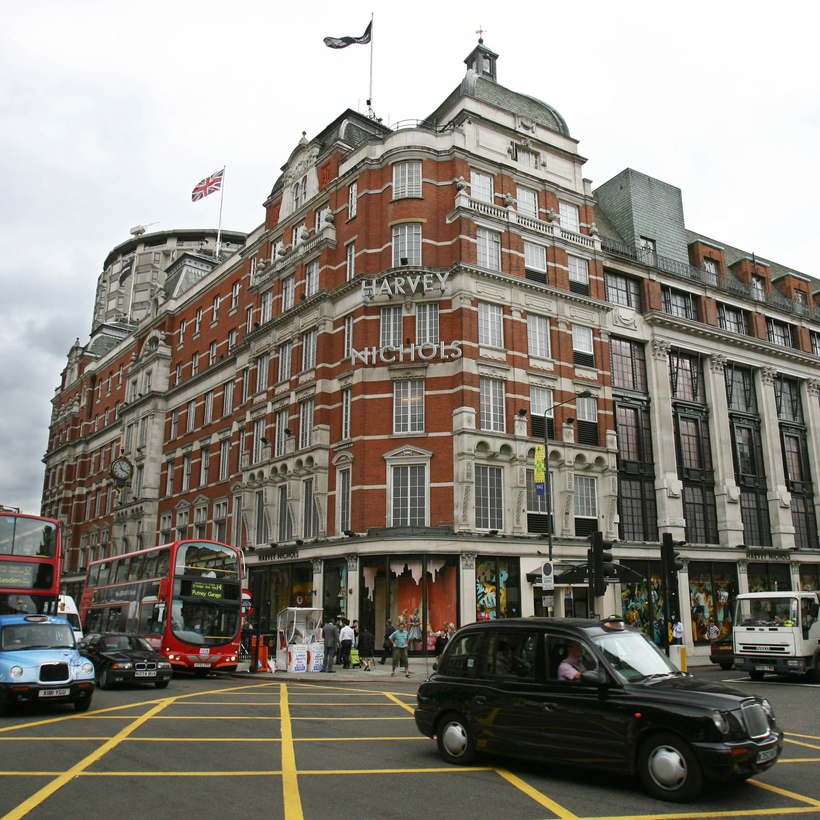Another day, another nepo-baby ascent story. But when we’re talking about the 29-year-old who has just taken the helm at Harvey Nichols, even the most Botoxed eyebrows will be raised.
The Cambridge graduate in question, Pearson Poon, is the son of Sir Dickson Poon, the retailer’s 67-year-old chairman and owner. He has been promoted to vice-chairman and will lead the business until a replacement has been found for outgoing C.E.O. Manju Malhotra, whose focus on post-pandemic cost-cutting wasn’t enough to offset a $38 million loss in 2022.
And so, as a new day dawns at Harvey Nichols, the fashion-loving masses can’t help but wonder: Is it too little, too late for this former arbiter of British style? “It’s a fascinating London story,” says fashion consultant Averyl Oates, who was the buying director at Harvey Nichols from 2004 to 2012. “Because of what it stood for, but also, what it’s lost.”

When Poon the elder bought Harvey Nichols, in 1991, the London establishment feared for the future of Princess Diana’s favorite shop. The press dismissed Poon as an outsider who had made his fortune selling watches in Hong Kong; how could he possibly understand the small but mighty anchor of Sloane Street?
But Poon was savvy. Among his first orders of business was hiring a crackerjack young buyer named Mary Portas, who had an uncanny radar for needle-moving fashion. Even though Harvey Nichols was relatively small in size—220,000 square feet to Harrods’ 1.1 million—it punched above its weight in terms of impact.
“When you’re really big, you just buy everything,” says Oates. “The smaller you are, the more difficult it is. But one of the pluses is it’s manageable—you go in and you see a fantastic edit, the best of the best. It was the perfect multi-brand corner store.”
Presciently, Portas gave clothes to the producers of a new television show in exchange for plugs in its scripts. By late 1992, Absolutely Fabulous was a smash, and its protagonists, Lacroix-loving Edina Monsoon and Patsy Stone, swooned, “Harvey Nicks!,” as the chattering classes still refer to it, almost as often as they lit cigarettes. (Monsoon, a fashion publicist, was said to be based on Lynne Franks, who handled P.R. for Harvey Nichols.)

That same year, Alexandra Shulman was the newly minted editor of British Vogue. “The first place I went was Harvey Nichols to look for clothes to wear to the [fashion] shows,” she recalls. To differentiate itself from neighboring Harrods, which was owned by Mohamed Al-Fayed and considered dowdy, Harvey Nichols bet big on emerging designers such as Stella McCartney, Matthew Williamson, and Clements Ribeiro, who helped turn London into a fashion capital that could rival Milan, Paris, and New York. Portas and her team of buyers took pains to entice the hottest American brands as well; Donna Karan, Ralph Lauren, and Calvin Klein had prominent positioning on the venerated first floor.
Harvey Nichols was also shrewd about marketing. “Portas was brilliant at visual merchandising; they established these eye-catching windows and ad campaigns,” says Shulman. “It remained in pole position for a very long time.” The windows even became stops on sightseeing tours.
The press dismissed Poon as an outsider who had made his fortune selling watches in Hong Kong; how could he possibly understand the small but mighty anchor of Sloane Street?
In the aughts, during Oates’s time, Harvey Nichols hosted some of the most talked-about parties in town, transforming its sales floors into opulent dinners for then emerging designers such as Lanvin’s Alber Elbaz. One such event, for the Row’s notoriously press-averse designers Mary-Kate and Ashley Olsen, resulted in not only inches of newspaper coverage but also a surprise appearance by Amy Winehouse. “The centerpiece [of Harvey Nichols] was always about supporting and fostering new talent,” says Oates. “That was very attractive to the bigger brands as well. They saw it as a place of discovery.”

But that was then. A lot can happen in 15 years, especially if you throw in the advent of e-commerce titans such as Net-a-Porter and MatchesFashion, a few financial crises, and the departure of a talented, tenured C.E.O. (Joseph Wan, in 2013).
“Little by little, we lost the brands, we lost the customers, and we lost the ability to be able to negotiate,” says Oates. “For me, that was the writing on the wall.”
Not to mention the fearsome competition from Harrods, now owned by Qatar’s deep-pocketed sovereign-wealth fund, and Selfridges, whose majority shareholder is the billionaire Chirathivat family, of Thailand. Both stores have re-invented themselves, ditching the staid old department-store mentality and building out restaurants, salons, and cinemas so that even the shopping-averse will find a reason to pop in. (And maybe buy a lipstick or sweater.)

Harrods even converted its sales floors to shops-in-shop, which luxury brands love—their merchandise is sold in a dedicated space, against a backdrop of its logo, and never mixed on the racks with items from its competitors.
Those strategies proved successful; Harrods’ 2022 revenue was $1.25 billion, up almost $500 million from 2021; and Selfridges’ was $822 million, another significant increase. Harvey Nichols, which operates stores in Bristol, Manchester, Edinburgh, Leeds, and Birmingham as well as London, had revenues of just $241 million.
“Cash is hard-earned,” says Serena Hood, a former Vogue editor who co-founded the stylish online shop Collagerie. (Some could argue it’s the natural successor to Harvey Nichols.) “You have to provide a compelling reason for customers to come to you.”
In London, where cool weather shows up on September 1 and doesn’t retreat until June, back-to-school shopping is a blood sport. On a recent Wednesday morning in Knightsbridge, women with zero arm fat and hundred-dollar blowouts swarmed the registers at Harrods, arms filled with Toteme’s gray flannel suiting, the Vampire’s Wife caftans, and even a few fillets of sea bream from the Food Halls. (Only $60 a pound!) It was hardly even lunchtime, and yet the Moët & Chandon bar, in the beauty department, was heaving.
Meanwhile, the place down the block was crickets. At 11 a.m. at Harvey Nichols, the bored sales associates scrolling through their phones outnumbered the equally disinterested shoppers. I counted only eight breakfasters on the once happening fifth floor. A display of the latest caps and bags from Ganni was littered with wads of tissue paper.
But its loyalists haven’t abandoned hope of a better future, provided it can recapture that heady mix of emerging designers, eye-catching displays and windows, and strategically placed buzz. “The marketplace is now absolutely saturated, which is why I feel like it’s actually the time for places like Harvey Nichols,” says Oates. “It’s the recipe that, today, everyone is looking for.”
Ashley Baker is a Deputy Editor at AIR MAIL and a co-host of the Morning Meeting podcast


